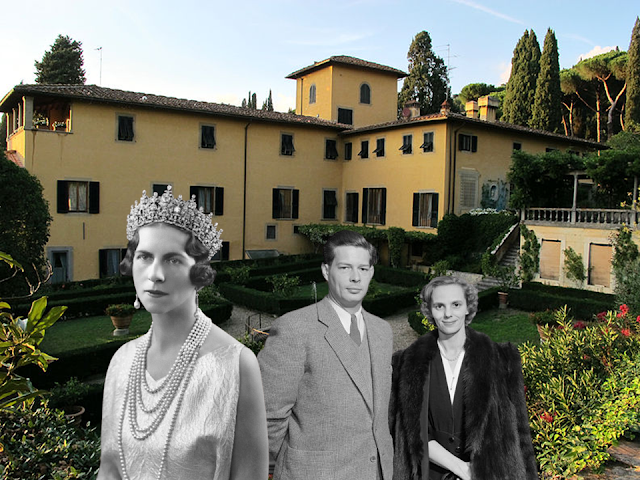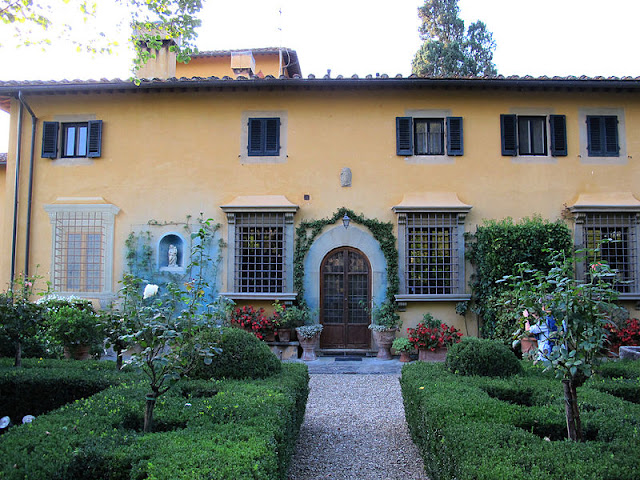Located on the gentle slopes of Fiesole, a charming town just on the edge of Florence in Tuscany, the Villa Sparta was, for four decades, the home of Queen Helen of Romania. Here, she opened her doors to a host of royalty, ranging from kings and queens, princes and princesses – all Queen Helen’s family and relatives – to members of the expatriate communities and the intelligentsia.
Queen Helen was born a Princess of Greece and Denmark, in 1896, in Athens, Greece. She was the eldest daughter of King Constantine I and Princess Sophie of Prussia. On March 10, 1921 she married the Crown Prince Carol of Romania. However, shortly after the birth (1922) of their only child, the future King Michael I, Carol abandoned Helen and officially renounced his rights to the Romanian throne to live with his mistress, Magda Lupescu. Helen and Carol officially divorced on June 21, 1928. After the death of her father-in-law, King Ferdinand of Romania, her son who was only five years old, ascended to the throne in July 1927. Helen, however, was not part of the regency council and did not hold any official position. Three years later, Carol staged a comeback and, with the support of the population and the political class, Carol proclaimed himself King of Romania. Michael was demoted to being heir to the throne.
Feeling harassed by Carol’s treatment of her, Helen travelled to Italy in November 1931 and took up residence at her mother’s home, then called Villa Bobolina, in Tuscany. If there was one thing that Helen benefited from this conflict with Carol, it was the substantial monetary compensation that she received. Helen was granted a sum of thirty million lei to buy a home abroad and in addition she obtained an annual pension of seven million lei. At the time, her mother, the Dowager Queen Sophia of Greece, was already ill with cancer and died in January 1932. With her financial settlement, Helen bought Villa Bobolina in Fiesole and she renamed it Villa Sparta. Here, she convalesced her broken heart and nurtured her creative passions in gardening, history, architecture, and the arts.
Located near the convent of San Domenico, this Renaissance structure originally belonged to the Buoninsegni family until ownership passed on to many hands. At the beginning of the twentieth century it was restored in style by Giuseppe Castellucci. In the 1920s, the villa, by now called Bobolina, was owned by an American named Wilkins. The property then consisted of three small cottages and 20 hectares of land. It was leased by Queen Sophia of Greece, shortly after the death of King Constantine I in January 1923. The exiled queen dowager and her daughters Irene (later Duchess of Aosta) and Katherine, decided to leave Southern Italy and resided in Tuscany. Later, they were joined by her daughter-in-law, Princesses Aspasia (widow of King Alexander I of Greece), and Sophia’s granddaughter, Princess Alexandra. After Queen Sophia’s death in 1932, Helen snapped the property.
Beginning in 1933, Helen redeveloped the villa, and for the next thirty years, the property saw her greatest splendour. The exiled royal immediately embarked of turning her new home and gardens into a charming royal residence. She hired the well-known landscape architects Cecil Pinsent and Pietro Porcinai to restore the villa's garden in the Italian neo-classical style.
In this small medieval palace extended and rebuilt over four centuries, Helen sought refuge and healing after finding that life at the Court of Bucharest became impossible. Humiliated beyond the limits, Helen was forced to leave her son in the care of his father. In Fiesole, she longed and waited for her son, whom she only met twice a year, two weeks at a time. It was on his brief excursions in Fiesole where Michael was happiest. He enjoyed Villa Sparta’s relaxed atmosphere and the freedom her mother’s household afforded him. He also delighted in reuniting with his relatives in Greece and other countries, including his cousin, Prince Philip, who also frequented Helen’s home.
The expansive garden, rebuilt at the queen's behest after Renaissance patterns, fascinated anyone who would visit Villa Sparta. During her exile from 1932 to 1940 she dedicated her time and energy in developing the villa and its garden, making it a place of elegance, refinement and hospitality. In Fiesole, the life of Helen and her sisters Irene and Katharine (who frequently visited her) was relatively retired. Members of the Italian Royal Family always came by. No sooner, Villa Sparta attracted different personalities from the artistic and cultural circles, more so her royal relatives and the nobility. She also became part of the circle of foreign intellectuals who resided in the hills of Florence, including Bernard Berenson, Harold Acton and Cecil Pinsent.
She returned to Romania after the abdication of Carol in 1940. With her son now King, Helen was proclaimed Queen Mother and served his son’s most trusted advisor. During World War II, under the fascist regime of Ion Antonescu, Queen Helen worked to save thousands of Jews, including orphaned children. Because of her humanitarian work, in 1993, eleven years after her death, the State of Israel proclaimed her as "Righteous Among the Nations" and her name appears in Yad Vashem in Jerusalem. In 1945, Michael staged a coup that toppled Antonescu’s regime, but a Soviet-controlled government forced Michael at gun-point to abdicate in 1947.
Again, Helen took refuge in her beloved Fiesole. This time, she brought with her Michael and his new bride, the former Princess Anne of Bourbon-Parma, whose father, Prince Rene, was the nineteenth child of Robert I, the last Duke of Parma. In this hill full of chic villas, many centuries old, Helen, her son, and his young family, started a new life. Over the years, Michael’s family grew with the successive births of princesses Margareta (1949), Elena (1950), Irina (1953), Sophie (1957) and Maria (1964). In 1951, the young king and his family decided to settle in Switzerland, where Michael had found work, but they would always frequent Villa Sparta. Offering a superb panorama overlooking the breathtaking view of Florence, the young princesses enjoyed the time they spent with their grandmother.
From 1949 to 1950, Helen also housed her sister Irene, Duchess of Aosta, and her nephew Amedeo, later Duke of Aosta, who later settled in a neighboring residence. Over the years, the two Greek princesses retained a strong bond, which ended with the death of the duchess of Aosta in 1974. Throughout her life, Helen also remained deeply attached to Amedeo and his first wife, Princess Claude of Orléans. Helen maintained a strong bond with her European relatives and she would always travel abroad, especially to the United Kingdom, to see her granddaughters, who were studying there. Despite her sometimes stormy relationship with her sister-in-law, Queen Frederica, Helen also spent long periods in Greece and even participated in the cruise of the Kings in 1954. She also attended the wedding of Princess Sophia and the future King Juan Carlos I of Spain in 1962, and the events organized to mark the centenary of the Greek dynasty in 1963.
Princess Elizabeth and the Duke of Edinburgh visit his cousin, Queen Helen of Romania, at the Villa Sparta near Florence #OnThisDay 70 years ago, where they were joined by King Michael and Queen Anne of Romania and Princess Irene, Duchess of Aosta!https://t.co/9IzueDbCOV pic.twitter.com/c53ReaVozQ
— The Royal Watcher (@saadsalman719) April 18, 2021
In Villa Sparta, Queen Helen nurtured her interest for the Renaissance architecture and painting, doing extensive visits to nearby monuments and museums. Her creativity extended to creating artistic objects, just like an engraving made with a dentist's drill on an ivory billiard ball. A gardening enthusiast, she spent many hours among the flowers and shrubs of her residence and her passion for plants resulted to Villa Sparta’s immaculate gardens. From 1968 to 1973, Helen had a romantic relationship with the twice-widower King Gustaf VI Adolf of Sweden, with whom she shared a love of art and plants. At one point, the Scandinavian sovereign asked her to marry him, but she refused.Years earlier, Philip and his cousin and childhood playmate King Michael of Romania posed in the same spot. 😎
— Daria (@amidstreverie) February 23, 2021
📍Villa Sparta, Fiesole. Florence. pic.twitter.com/RwoDwmZjdf
In 1956, Helen gave her consent to Arthur Gould Lee, who wrote her biography. Since leaving Romania in 1947, Helen endured financial difficulties, which only worsened over time. Aside from the need to maintain Villa Sparta, she also had to support her son and his family, including the studies of her eldest granddaughter, Margareta, who lived with Helen for a year at Villa Sparta before entering a British university. To stay financially afloat, Helen has to sell her assets, including jewellery and artworks, one by one. By the early 1970s, Helen was so financially drained that she had nothing to sell anymore. Queen Anne later confessed that she tried to help Queen Helena keep Villa Sparta by selling most of the jewels she had inherited from her father. In 1973, she mortgaged Villa Sparta and three years later, she sold the two Greco paintings that she had brought with her from Romania in 1947. She finally settled on a tiny apartment in Lausanne, Switzerland before moving into her son’s home in Versoix.
As to the fate of Villa Sparta, it was eventually divided into seven distinct apartments. Here are some photographs of the interiors:



















.png)





4 Comments
Queen Anne was a granddaughter of the wealthy Robert of Parma and not his daughter. Her father Prince Rene of Bourbon Parma didn't receive a large share of the wealth of Prince Robert. A few years before her death Helen eventually sold the villa and moved in with Michael and Anne.
ReplyDeleteThank you! The necessary revisions were done.
DeleteYou mentioned the stormy relationship Helen had with Queen Frederica. It is the first time I hear of this. Could you please provide more info about the reasons why they had such a relationship? Thank you
ReplyDeleteApparently a few family members had trouble with Queen Frederica. Princess Andrew also had issues with her.
Delete